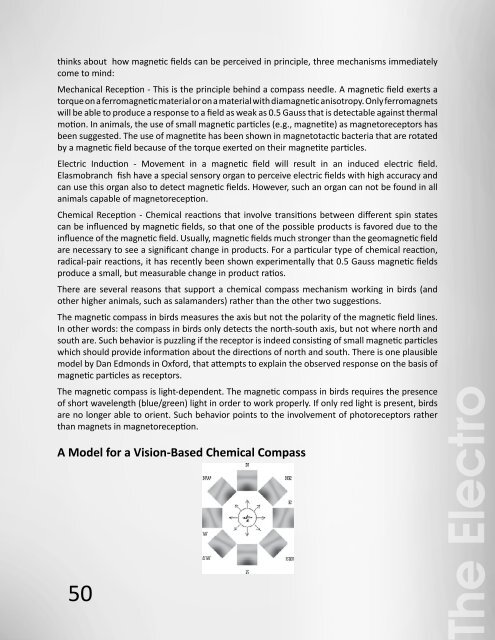The Electro Sense
The Electro Sense
The Electro Sense
- No tags were found...
Create successful ePaper yourself
Turn your PDF publications into a flip-book with our unique Google optimized e-Paper software.
thinks about how magnetic fields can be perceived in principle, three mechanisms immediatelycome to mind:Mechanical Reception - This is the principle behind a compass needle. A magnetic field exerts atorque on a ferromagnetic material or on a material with diamagnetic anisotropy. Only ferromagnetswill be able to produce a response to a field as weak as 0.5 Gauss that is detectable against thermalmotion. In animals, the use of small magnetic particles (e.g., magnetite) as magnetoreceptors hasbeen suggested. <strong>The</strong> use of magnetite has been shown in magnetotactic bacteria that are rotatedby a magnetic field because of the torque exerted on their magnetite particles.Electric Induction - Movement in a magnetic field will result in an induced electric field.Elasmobranch fish have a special sensory organ to perceive electric fields with high accuracy andcan use this organ also to detect magnetic fields. However, such an organ can not be found in allanimals capable of magnetoreception.Chemical Reception - Chemical reactions that involve transitions between different spin statescan be influenced by magnetic fields, so that one of the possible products is favored due to theinfluence of the magnetic field. Usually, magnetic fields much stronger than the geomagnetic fieldare necessary to see a significant change in products. For a particular type of chemical reaction,radical-pair reactions, it has recently been shown experimentally that 0.5 Gauss magnetic fieldsproduce a small, but measurable change in product ratios.<strong>The</strong>re are several reasons that support a chemical compass mechanism working in birds (andother higher animals, such as salamanders) rather than the other two suggestions.<strong>The</strong> magnetic compass in birds measures the axis but not the polarity of the magnetic field lines.In other words: the compass in birds only detects the north-south axis, but not where north andsouth are. Such behavior is puzzling if the receptor is indeed consisting of small magnetic particleswhich should provide information about the directions of north and south. <strong>The</strong>re is one plausiblemodel by Dan Edmonds in Oxford, that attempts to explain the observed response on the basis ofmagnetic particles as receptors.<strong>The</strong> magnetic compass is light-dependent. <strong>The</strong> magnetic compass in birds requires the presenceof short wavelength (blue/green) light in order to work properly. If only red light is present, birdsare no longer able to orient. Such behavior points to the involvement of photoreceptors ratherthan magnets in magnetoreception.A Model for a Vision-Based Chemical Compass<strong>The</strong> <strong>Electro</strong><strong>Sense</strong>We propose a magnetosensory organ that consists of a system of radical pairs that are orientationallyordered in the eye. We propose that a photoreceptor is part of the radical-pair system and thatits sensitivity is modulated through the magnetic field effects on the radical-pair system. If oneassumes an anisotropic hyperfine coupling, one can calculate in a simple radical-pair model howthe response of the photoreceptor is changed depending on the angle of the magnetic field lineswith the radical-pair system. Assuming that the radical-pair/photoreceptor system is distributedequally over the whole eye, one can evaluate how vision of a bird is modulated. <strong>The</strong> cartoonson top of the page illustrates how a bird converts an unprocessed image to an image whichprovides directional information through a radical-pair system obeying the stochastic Liouvilleequation. To the left, the visual modulation patterns are shown for a bird flying parallel to thehorizon (geomagnetic field lines at an angle of 68 degrees with the horizon) and looking towardsN,NE,E,SE,S,SW,W, and NW. <strong>The</strong> patterns are projected into the plane.<strong>Electro</strong>n transfer processes which generate radical pairs in coherent electron spin states (singletor triplet) are affected by weak magnetic fields [Schulten et al., Z physik. Chem. Neue Folge 101(1976) 371]. Based on this finding we suggest a reaction mechanism for a chemical compass whichexhibits a sensitivity on the orientation of the geomagnetic field originating from an anisotropy ofthe hyperfine interaction experienced by unpaired electron spins in a redox process. It is arguedthat such mechanism may explain the ability of many biological species to orient themselves inthe geomagnetic field.A large variety of animals has the ability to sense the geomagnetic field and utilize it as a sourceof directional (compass) information. It is not known by which biophysical mechanism thismagnetoreception is achieved. We investigate the possibility that magnetoreception involvesradical pair processes which are governed by anisotropic hyperfine coupling between (unpaired)electron and nuclear spins. We will show theoretically that fields of geomagnetic field strength andweaker can produce significantly different reaction yields for different alignments of the radicalpairs with the magnetic field. As a model for a magnetic sensory organ we propose a system ofradical pairs being (1) orientationally ordered in a molecular substrate and (2) exhibiting changesin the reaction yields that affect the visual transduction pathway. We evaluate three-dimensionalvisual modulation patterns that can arise from the influence of the geomagnetic field on radicalpair systems. <strong>The</strong> variations of these patterns with orientation and field strength can furnishthe magnetic compass ability of birds with the same characteristics as observed in behavioralexperiments. We propose that the recently discovered photoreceptor cryptochrome is part of themagnetoreception system and suggest further studies to prove or disprove this hypothesis.50 51
















